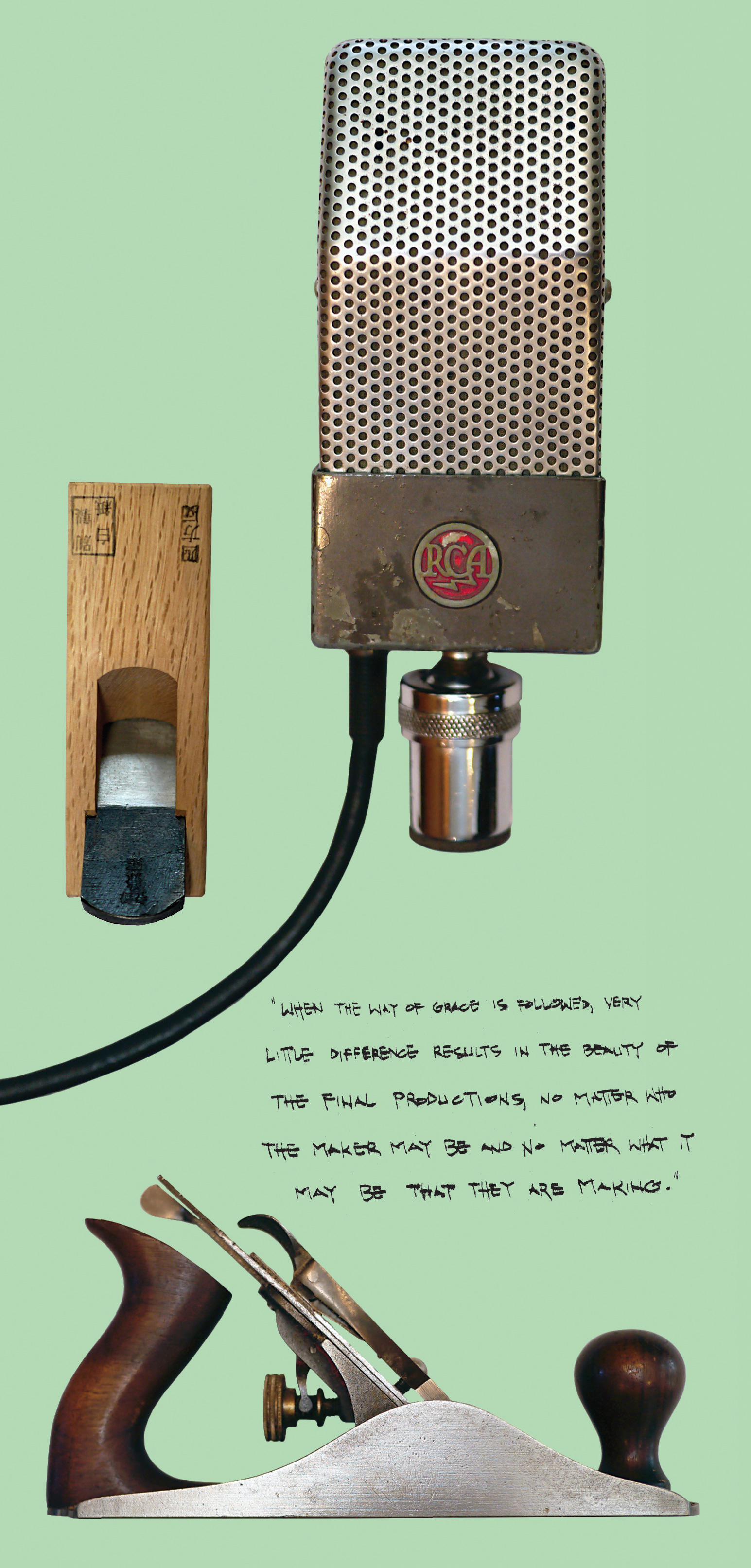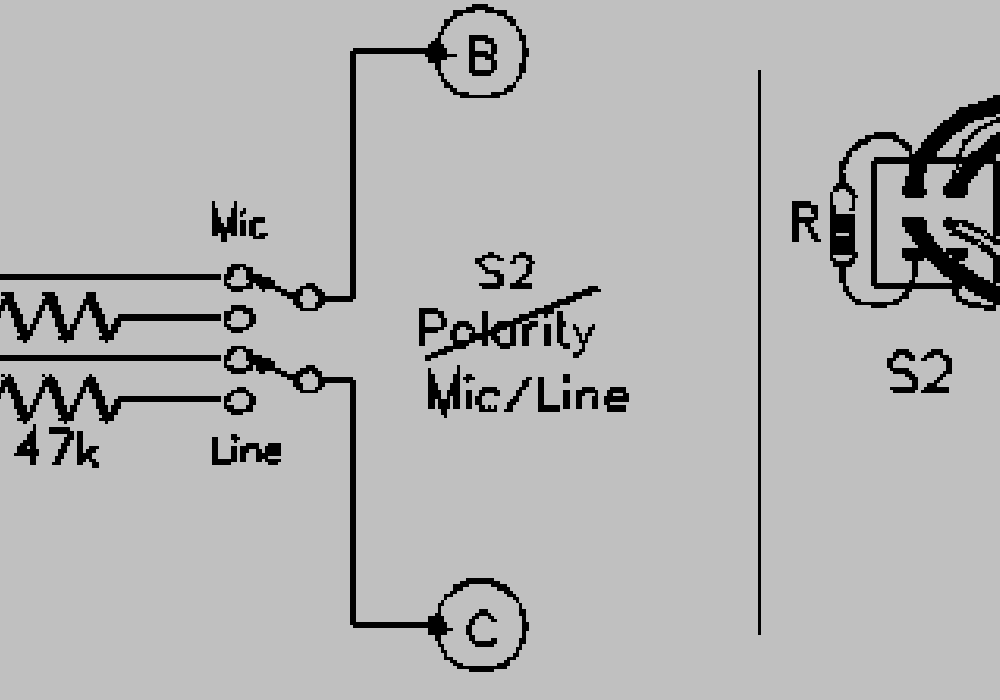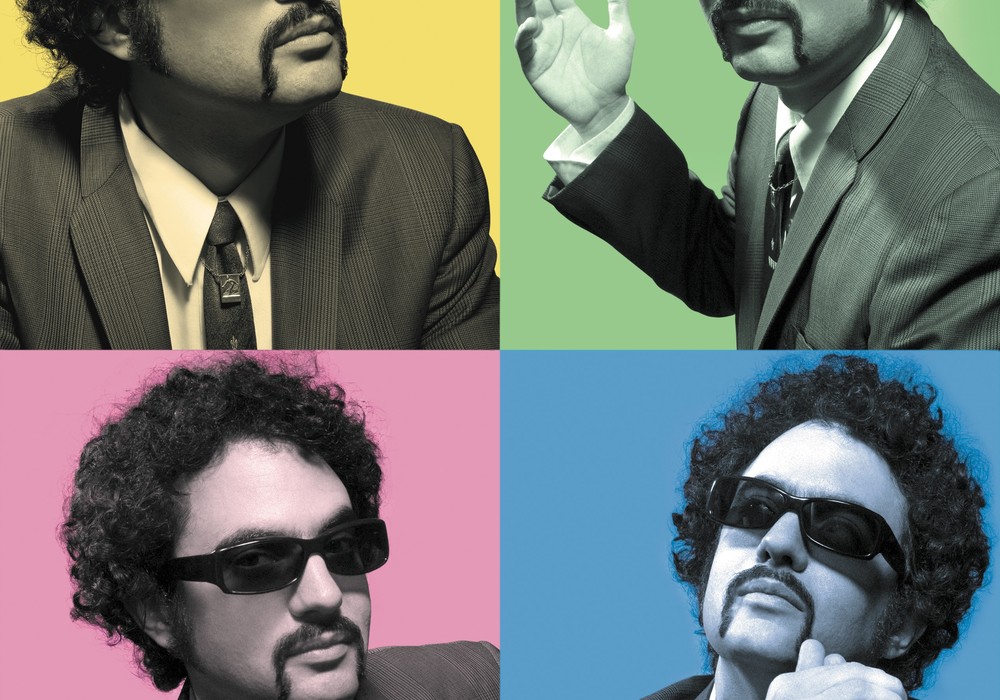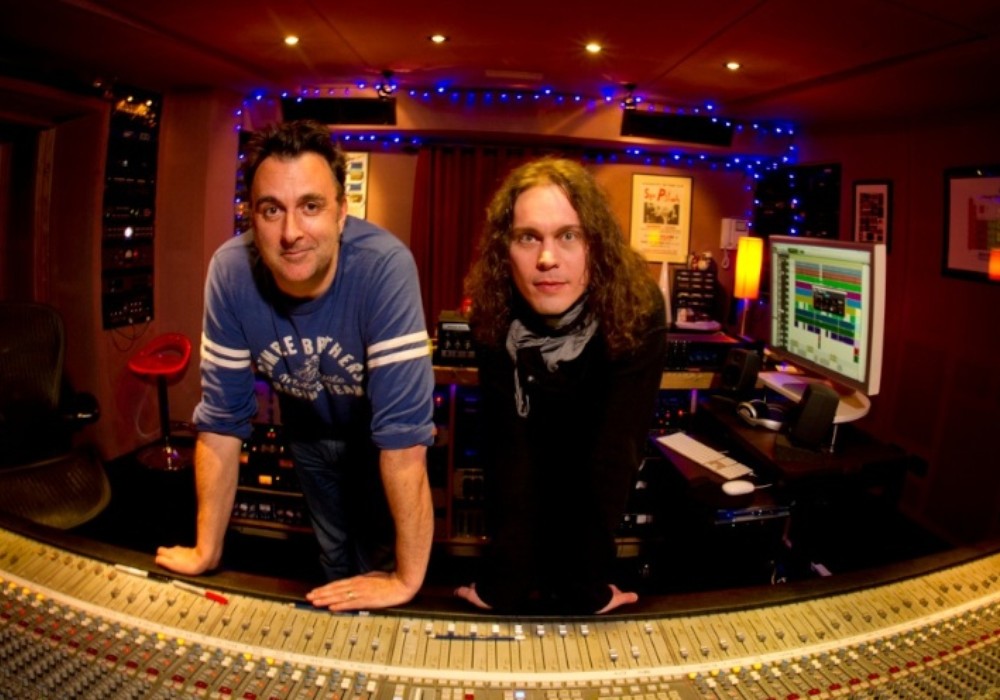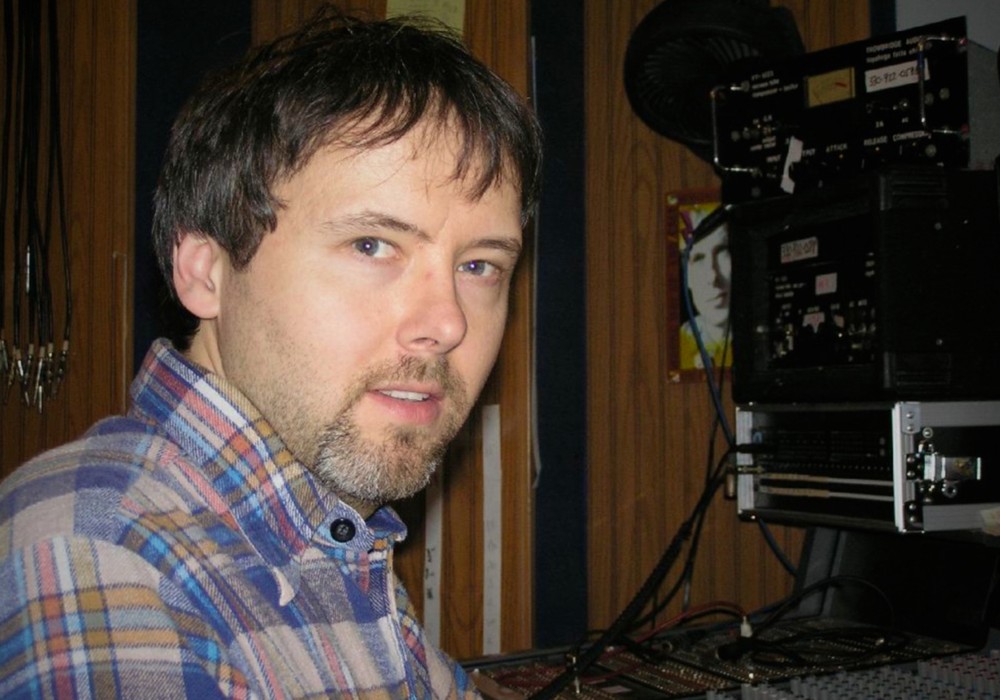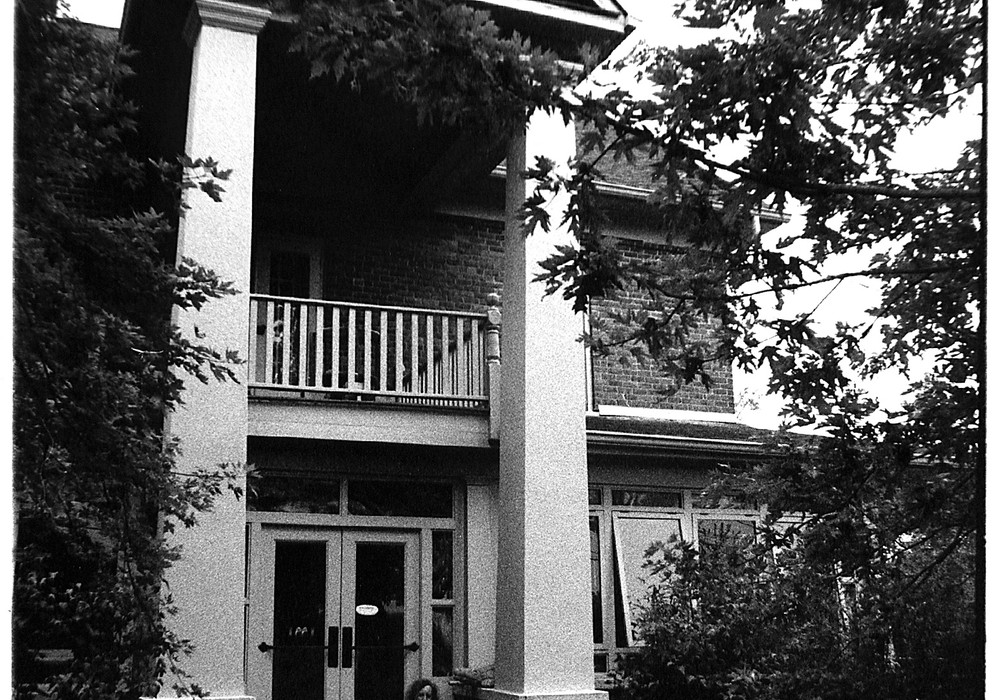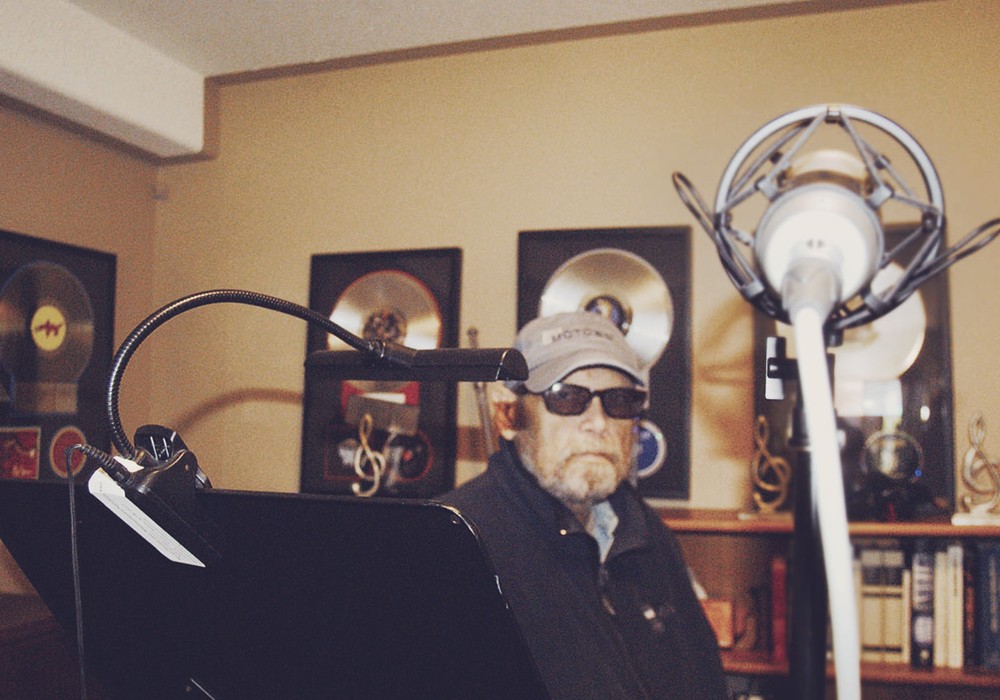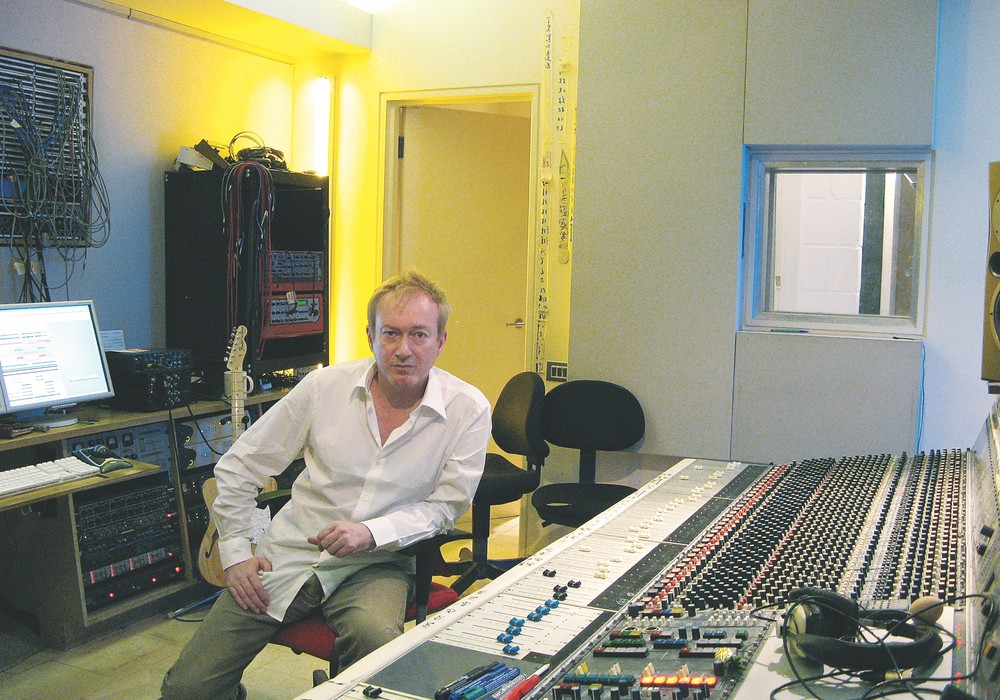Bob Clearmountain is no stranger to the pages of Tape Op, as we’ve chatted with him in issues #84 and #129. But when Marlene Passaro at Apogee Digital asked us if we’d be interested in a discussion between Bob and Jesse Ray Ernster, a young mixer he admires, we said yes. Bob is a legend for his work with Bruce Springsteen, David Bowie, and Chic, and Jesse is working with popular artists such as Doja Cat, Burna Boy, UMI, and Kanye West.
Jesse grew up in Minneapolis, Minnesota, surrounded by music. His mother was a singer/songwriter, and his father was a multi-instrumentalist producer with a lakeside home studio. “My dad liked to make records with his friends and hang with the family.” His dad recorded Jesse’s bands, but soon Jesse decided he liked being in the studio more than touring. He focused on studio work as well as mixing, and soon found himself teaching recording at the Minneapolis Media Institute based in the legendary Flyte Tyme Studios. When MMI shut down in 2016, Jesse decided it was time to make the move to Los Angeles, California, where there was more infrastructure to work in music and mixing.
Bob and Jesse work quite differently; Bob on his SSL G Series console, and Jesse entirely in the box (although he does have a few pieces of hardware that he uses on inserts, he’s not using any analog summing). His control room is also unique as there is no console or desk, just a wall of modified Yamaha NS-10 monitors. “When I got rid of the desk, all the reflections and comb filtering went away,” he explains, “so the monitoring is super accurate now.” Read on as Bob and Jesse compare and contrast how they get into the mix. -JB
Let’s get started:
Jesse Ray Ernster: Hi, Bob! Nice to see you. What are you working on these days?
Bob Clearmountain: Hi, Jesse. Nice to see you! We’re about to start doing some radio shows again here at Apogee, and hopefully maybe some live streaming. We’ve upgraded our video setup, which is my own little personal project I’m having fun with. Being an audio guy, it’s fun messing around with home video a little bit.
The philosophy of mixing and being along for the ride:
BC: I’m looking forward to hearing what you do, actually. I know what I do.
JR: There are two different ways that I could approach this. I think that in the first few years of learning to do what we do, there’s this gap between hearing the song and having the ideas. Then there’s being able to execute them, hearing the result, and being happy with that result. Especially now, with computers and technology, there are so many stages and kinks to work out. How many mouse clicks come between having the idea to boost the presence and the overall quality of a vocal? How many steps does it take to get there, to where I’m hearing it and I’m pleased? Then, usually once I’ve actually gotten there I can say, “Okay, I’ve successfully found the plug-in and boosted the top end, but now it’s not right.” How many times am I refining and having to go back to do that? I feel like once I can get into the mix, once I hit that point where I’m not even consciously thinking about the technical attributes of the job, I’m just thinking musically, grooving, and that’s when I really get in.
In and out of the box:
BC: You were saying mouse clicks and plug-ins, and that’s the difference, obviously, between the way that you and I work. I work on an analog desk. I do use plug-ins a bit, but usually more when I run into problems. If I can’t quite get to it on my SSL, I’ll turn to a plug-in. Most of the time, it’s easier because of the way everything’s laid out in front of me, and I just have to grab knobs. I don’t have to think. I hardly have to think at all, because it becomes instinctive. It’s like playing a guitar. If you’re a good guitar player, you don’t think about what your finger’s going to go to next, what fret. I don’t have to think about clicks, plug-ins, and what plug-in is going to work. I have the same equalizer on every channel. I’ve got a couple of things in the rack, but those are for specialty work. I think what you’re talking about for us old guys is a stream-of-consciousness process. I listen to your records, and I don’t know how you can keep your sanity while having to open plug-ins and figure out which plug-in you’re going to use on a particular thing. It seems like there are a whole lot more decisions that you’re going to have to make when you’re mixing. I know when I sit down and try to do a mix in the box, I just get pissed off. I want to take the thing and fucking throw it in a pool. [laughter] It pisses me off. How do you deal with that?
JR: You have to automate. I use keyboard macros, customized shortcuts, and different commands and scripts, along with a template that my assistant preps out. That way I’ll have the same EQ on everything, at least for a starting point. It’s the only way to make it flow, because I’m super impulsive, impatient, and very hyperactive ADHD. I don’t run the mix through a factory of the same settings or anything like that. I don’t template a mix, but it needs to be fast. Once I managed to get that going, it was definitely becoming fun. Now, it’s like when I used to gig. I’d get halfway through a set and realize that I have not been conscious for any of it! Instead, I’ve been daydreaming about my plans next Thursday. [laughter]
BC: That happens to me a lot. I’ll be sitting there mixing, and I always go through these stages. When I first put something up, there will be a lot of times where I think, “What the fuck am I going to do? This one’s beyond me, and I’m never going to get through this.” I don’t know if you feel that way?
JR: Yes.
BC: I just sit there like, “Oh, fuck,” just playing it and thinking, “Maybe I can fix this vocal sound.” Or, “Maybe put some nice ambience on the vocal.” I start with the vocals, and then I’m usually dealing with rock, so it’s guitars. I think about the guitars early on, and what they are all doing. Where am I panning them? Left or right? What are the percussion and the drums doing? Before I know it, like you’re saying, it’ll be two hours later, and it actually sounds like something. I always think, “How did that happen? What did I do?” I don’t even know, because I let the music tell me what to do.
JR: It’s those thousand little micro moves that get you there. Michael Brauer [Tape Op #37, #131] has an expression he’ll use: “I’m in.” Two, three, or four hours in, after he’s been crawling through the muck and sorting and moving, “Okay! It’s sendable. We’re in.” I’ve completely adopted this. I always say it out loud, whether I’m by myself or if I’m mixing with an assistant. “We’re in.” Then I can have fun, and I’ll get going with all the automation and start adding in production bits. Flair, tweak the arrangement, or listen through and see what happens.
BC: Then I’ll put the whole thing through a flanger.
JR: Yeah, get wild with it! A lot of music is so static these days. Those spontaneous moves, more often than not I’m finding that they’re accepted, and the clients are becoming more receptive.
BC: Yeah, that’s good.
Demo-itis:
JR: For several years I was working with artists who suffered from “demo-itis,” and they needed to match the rough. That is still the world I live in, and it might be a cool thing for us to touch on. I think you get the freedom to build a mix and push the faders up on the desk. The sessions that I receive, I open any session in Ableton [Live], [Apple] Logic, [Avid] Pro Tools, or [PreSonus] Studio One, and those faders are already up. That session is populated. The mix bus is completely full of plug-ins, most of the time. These are fleshed-out pop productions that are already completely realized, and already sounding mixed.
BC: What do you do then?
JR: It becomes stem mastering. A little bit of mix bus mixing, and tweaking. Just overall broad strokes, as well as a lot of automation. For me it’s a lot of clip effects like EQ automating, phrase by phrase. Kind of like Mike Shipley [Tape Op #118] muddling, OCD-style, to get everything hitting the same way. A lot of the time it’s correcting their gain staging. Usually it’s really loud and smushed; there are ways to back that off and reshape the way their transients hit.
BC: So it’s not just compressed to hell.
JR: Yeah. The job I do most of the time is matching their loudness, because they’re going to be used to that loud version. Getting it to match the loudness, but with the transients added back in for more punch.
BC: Right, with some dynamics.
JR: Yeah. “How do I get it louder, with more dynamics?” That’s been the mission the last few years.
BC: That’s interesting. For me, I turn all that crap off. I get rid of all of it.
JR: That’s what I used to do.
BC: Get rid of all the automation and start over.
JR: I’d get fired. Every time!
BC: Yeah, it’s a different era, I guess. Then I listen to their mix. If they haven’t printed one, I’ll take their session and print one.
JR: Same.
BC: I’ll constantly refer to that, so that I’m not too far off from what they wanted to do. Then, from there, I’m just trying to improve on what they did.
JR: Yeah. They’re so used to it. Sometimes listening to their reference mix, I can tell a lot about their listening environment. I can tell from the way they made this [working mix] that they’re in a room with inadequate treatment, and inaccurate monitors. They made up for that by making it very mid-rangey and mucky. They’re going to hear my brighter, cleaner version of their mix, and it’s going to sound way scary. Then the questions are, “Do I meet them in the middle, or do I trust my gut? Is this going to sound the best to the consumer?” Maybe this would be a good time for you and I to move into the psychology of it, and the Jedi mind tricks. Do we mix for the client, or do we mix for the culture?
Thoughts on mixing:
BC: I mix for myself. I used to do that years ago. But I was lucky, because what happened to me was I always mixed for myself, but it came to be that then people started copying me. I didn’t have to mix for anybody else anymore. It’s different now, of course, but back in the ‘80s it seemed people were listening to my records and trying to sound like those. It blew my mind, to be honest. I thought, “What are you people doing? Get a life! Come up with your own shit.”
JR: Absolutely. In the ‘80s, between you and Hugh [Padgham, Tape Op #55], you guys were completely the dominating SSL forces behind the sound of the gated non-linear reverb, for instance. You mentioned that you were mixing like you; then everybody wanted that sound, so they kept going to you for that sound. I think that you and I have that in common. We’ve been attached – maybe unfortunately – to a specific thing that we did, at one window of time. Then we’ve continued to be known as the people attached to that sound.
BC: Right. Then I immediately want to rebel against that. You mentioned Robbie Robertson when we were speaking earlier. When I started working with him, Daniel Lanois [Tape Op #37, #127] produced his first album [Robbie Robertson]. He did an amazing job. He’s an incredible producer. But he said to Robbie, “Oh, don’t get that Clearmountain guy. You’ll have that ‘Born in the U.S.A.’ snare drum plastered all over your record.” Of course, to me, “Born in the U.S.A.” was about as far away from anything that I thought was good.
JR: That’s the best part about it.
BC: Don’t get me wrong. I love Bruce’s records, but that was a Bruce thing. That’s what he wanted. He pushed me to do that. I knew how to do it. I figured out how to do it, but that’s not like some stamp I was going to put on it, that’s for sure. It was so funny. Anything like that, I tend to try and go in the opposite direction. Especially something that I’d get known for. Sometimes I’ll ask people, “Why did you want me to mix your record?” I’ll try and base what I’m going to do on that, a little bit. But, at the same time, I’m always trying to come up with something new and different. That’s why we do it. That’s what makes it interesting. It isn’t a day job where, “Okay, I know how to do drywall,” and so I’ll always do it the same way. We’re not putting up drywall. We’re mixing music.
JR: Yeah. There’s this drive, and this relentless obsession with achieving excellence.
BC: Yeah, and something unique, if you can. I hear it in your records, because I hear sounds that I have never heard before. I’ll think, “How did he do that?” I listen to your records and there’s all this space. I’m attracted to that. So much of the current music nowadays, as you were saying, it sounds very compressed, and flat, and linear. It sounds like it came out of a factory somewhere. I like space in music. I hear that in your records, where there’s dimension. There are things in the back, and in the front. I love that. If you listen to my records, you’ll probably hear that. That’s what I love, even though I’ve mixed some punk records and heavy rock records. Springsteen records, as an example, are the opposite of that. He likes everything really dense, so you don’t hear everything separate. There’s no space in it.
JR: Wasn’t your first Springsteen mix too clean and open?
BC: A lot of times, on mixes I’ve done for him, he’ll go, “No, that’s too clean. It sounds too good.”
JR: I get that quite a bit from artists. They don’t say the words, “It sounds too good to me.” They say, “It’s too clean.”
BC: “It’s too clean.” Or, “Can you make it rougher-sounding? More edgy?”
JR: Yeah. The common thread between the old records that sound great and now is the medium on which they’re being played. Before compact discs, there wasn’t a crazy loudness standard, so we were able to have headroom in recordings. There was no need to go wild with it. Now with DSPs [digital service providers] and streaming, they take care of that for us. I don’t need to beat anybody’s loudness other than the original reference mix for the artist when I’m trying to get an approval. That needs to be loud. As far as sending the master to a DSP, I fight as hard as I can for that headroom. I try to explain to people that if it’s not crushing into the ceiling, that’s what’s going to make it bounce out of the speakers. That’s what’s going to make it push air and create excitement.
Loudness:
BC: The loudness thing is ridiculous, while we’re on the subject.
JR: It’s stupid.
BC: People have volume controls on their iPhones, or whatever it is they’re listening to. They’ll set the volume to what’s comfortable to them, or to what’s going to destroy their ears! The loudness thing is just for A&R guys who come in and play their records around a table at an A&R meeting, and they want theirs to jump out more than anybody else’s. But that’s the only time that it’s important. I did a record once for a female rock artist. It was a rock record, but it had lots of dynamics. The guy who produced it was really good. It was a fun record to listen to. The guy who mastered it stuck it through a [Waves] L2 [limiter] and crushed it. Took all the dynamics out and made it louder than fuck. This poor woman called me up and she was in tears. “What happened to my record? Why does it sound like that?” She was so upset. The producer called me and said, “What happened?” I’ve never used that mastering guy again. I wrote to him and said, “What were you thinking?” He said, “Well, that’s what everybody’s doing now. That’s what everybody wants.” Count me out of that. That’s bullshit. I’m sorry.
JR: I have shed actual tears over mixes that have gotten destroyed.
BC: “What are you doing? I worked so hard on this.”
JR: What doesn’t make sense is that the teams allow that. The artist, the producer, and the A&R people at the label. People who go back and forth will do 40 rounds of mix notes to tweak the stupidest little stuff, like hi-hat volume. Then they get the master back and go, “Yeah, no problem. Submit.”
BC: I know. All those little tweaks mean nothing then.
JR: It’s super unfortunate.
The SSL EQ and “Closing Time” mix(es):
JR: I want to get an SSL. I’d love to use it as just hardware inserts. I don’t want to sum or anything. I’d do everything offline. I would love to put inserts on every track in the session and be able to EQ fast. I’m not going to use the automation, the summing, or the bus compressor. That’s the dream.
BC: Yeah. The equalizer on the SSL is great.
JR: Those filters are very, very punchy. When you overload the channels and get that crunch. I can hear that in your work. People think of you as the ‘80s guy, with Springsteen, but your work through the ‘90s and 2000s are the sounds I grew up on, like Semisonic’s “Closing Time.”
BC: Hopefully you’re thinking about my mix and not Jack [Joseph Puig]’s, because there were two mixes.
JR: Oh, really? You did the radio mix, right?
BC: No, that was Jack’s mix.
JR: Which one’s on the record?
BC: The one on the album is Jack’s mix. Dan Wilson [Tape Op #116] had called me up and said, “I’m really sorry, but we fell in love with this Jack Joseph Puig mix of ‘Closing Time.’” Then “Closing Time” came on the radio, and I’d forgot that he had told me that. I thought it was my mix, and I thought, “What?” [laughter]
JR: I love that it’s the mix I referenced right now.
BC: Yeah, all of a sudden, it occurred to me, “Oh, I know. I bet that was Jack’s mix.”
JR: This is the cool thing. As a fan, I dug into it, and I get this all the time. The mixes that I did on a technical level that I’m ashamed of, I won’t even put them on my website or the mix reel or anything. Often times they’re ones that have such an impact with listeners. They want vibe and imperfection.
BC: The single version on the East Coast is my mix, which is interesting. I don’t know why that happened. It depends on where you listened to it. I love those guys.
JR: Dan Wilson is a character.
BC: He’s amazing. A brilliant writer, and a really good guy. It’s so funny, because when I would mix with him for those guys, first of all, we’d always max out the desk completely. Every effect possible. “We need another delay on the backing vocals. Then we need another effect on the guitar, and we need another.” At one point I said to him, “Is this a test? Are you trying to see when I’m going to crack? I don’t have any more auxes. There’s no more gear in my room to do that.” I’m replacing things and trying to figure out how I can do it. There was no Pro Tools back then. It was all coming off tape. I couldn’t put in another plug-in!
The Divinyls:
BC: I’m lucky, because I’ve gotten to a point where most of the time people trust me. People certainly do make comments, like, “Turn up the strings,” or whatever it is. One of the best things that ever happened to me was a band called the Divinyls, back in the ‘80s. I had just mixed Roxy Music’s Avalon album, this big spacious thing.
JR: Clean, hi-fi dream.
BC: Big and wide. My next project was the Divinyls from Australia. They were a punk band, really. I’m mixing, and I’ve got Avalon in my head, which I’d just done. I made it real hi-fi, and the vocalist and the guitar player [Chrissy Amphlett and Mark McEntee] – the two main people in the band – I could see they weren’t happy. After the second mix, they finally said, “Can we talk to you for a minute?” They said, “We don’t think you’re getting who we are. We’re not big hi-fi. We’re not Roxy Music. We’re like this little spiky ball; this irritating thing with jagged edges coming out of it that are small, compact, and irritating. We’re a punk band.” I was like, “Oh!” I went back, listened to what I did, and thought, “Holy shit. Did I ever get this wrong! Let me start over.” I went back and got that new image in my head; then they were happy, and I nailed it. It taught me such a great lesson: Whatever the last project was, forget about it!
JR: Switch gears. Stay invisible.
BC: Try to figure out and get into your head what this artist is about and what they’re trying to convey. Think like them. Don’t think like whatever you had in your mind before you started this project. It’s so important. I know a lot of mixers are like, “Hey, this is my mix. Don’t fuck with my mix.” It’s like, “No, it’s not your mix. It’s the artist’s mix.”
JR: You mentioned earlier that you were coming from a place of luxury to be a part of your artists who were experiencing success. Like you were more of a passenger, grateful to be along for the ride and helping to bring those records to the masses. You have a very humble outlook. When you’re starting a mix or ending a mix, what’s the inner dialogue? What’s the side of Bob we don’t know about? Is it humble, confident, nervous, or excited?
BC: It’s easy for me to be humble, because I’m the best, of course. Everyone knows that. [laughter] No, actually I don’t know what the answer to that question is. I get totally absorbed by the mix and whatever it is that I’m doing. It completely takes over. I never have any preconceived notions. It sounds idealistic, I guess, but I absorb whatever it is that I’m mixing and then let it tell me what to do. I sit there and keep trying to make it better. I search out and try to get to the bottom of what the production is, or what the song is. Sometimes I’ll listen to the lyrics. Then I’ll say, “Okay, what’s playing the hook? What’s playing the melodies?” I learned from a guy [Tony Bongiovi, Tape Op #127], who started at Motown, and I used to watch him mix. Every time there was something that was a little hook-y part, he’d push that up. I’d watch his hands. That’s the most training I ever had, watching this guy. He was crazy, but he was very good. My own persona disappears completely when I’m mixing. I don’t think about it. It gets to a point where I say, “Oh, I know what I’ll do with this thing.” I might draw from something that I’ve done before. When it’s most exciting is when I can think of something new. The music tells me to do something. Unless you’re the artist, you’re just doing a service for somebody. It’s their show, so think like them.
Lose the ego:
JR: Totally. I don’t think that there’s any room for those types of egos anymore.
BC: I don’t think so. We’ve seen what huge egos can do to our country. It’s bad.
JR: Yeah. I’m thankful that in the music industry it seems we’re entering a new era of a progressive movement of inclusion. Overall there seems to be more empathy and teamwork in the process. There’s less hierarchy. All the way from the way that people come up at labels and studios. I want to see more equality with men and women doing this job. I’m raising two daughters. If they want to, I want them to feel safe and comfortable to work in music.
BC: That’s an interesting subject that you’re touching on, because there should be more women in this business. I’m really happy when I see women mixers and producers. It’s a good thing. As far as diversity too. It shouldn’t be all white guys. We should be the minority.
JR: Yep, 100 percent. That is one of the most beautiful parts of being in this day and age. Anyone from any walk of life can do it. Get a laptop and get an [Apogee] Duet and go. Start making records.
ATMOS:
JR: Where are you at with [Dolby] Atmos mixing these days?
BC: Well, love/hate really. I love mixing Atmos. My room is just wonderful. It’s so much fun. Basically, I’m mixing stereo and Atmos at the same time. I’ve been doing the same thing with 5.1 for over 20 years. Atmos is a few more speakers and some in the ceiling. I’m doing a stereo mix. While I’m doing the stereo mix, at some point I’m assigning speakers on my output buses. So, on the SSL there are my mix faders, and then there’s a small fader which is a send from the output of the mix fader to the multichannel buses. I’m assigning a few of those. But I’m listening to the stereo while I’m assigning those, while I’m doing the stereo mix. At some point, once I finally get the stereo mix happening and the automation and all my rides going and it sounds pretty good, I will switch my monitor over on my Apogee Symphony Mk II, which has full Atmos monitoring plus three sets of stereo speakers. I hit a button and I have stereo or Atmos. Then I’ll refine that, and say, “Okay, that doesn’t sound too good in the back. I’ll put that on the side.” Just move those around a little bit. Then I can trim. I’m using the small fader, which is normally at unity, at 0. That becomes a trim between the stereo mix and the Atmos mix. It’s just a fun thing for me. I’m listening to stereo most of the time, and then I click it over and all of the sudden it’s, “Whoa, this is cool!”
JR: The doors of perception have opened.
BC: Yeah. It’s big! All of a sudden, I’m sitting in the room with the band, and that’s what I really like.
JR: Totally. The contrast here is amazing. As mixers, especially in Atmos, I think that our workflow is exactly the opposite. You’ve got the mixer with a giant desk, analog hardware, mixing on a speaker system for Atmos. I have no desk, completely in the box, and spending most of the Atmos time in headphones.
BC: Right.
JR: We were touching a little bit on this behind the scenes. What are your views on the Atmos experience with speakers versus what the consumer will get when they listen to it on headphones or AirPods?
BC: It’s interesting, because the way I’m doing it, I can A/B between my stereo mix and my Atmos mix. I’m doing it at the same time. It’s just a switch. I can plug my headphones in and listen to the stereo mix, and then I can listen to the binaural mix out of the Renderer. It usually doesn’t sound quite as good as the stereo mix. Then I go back and try to adjust the Atmos mix.
JR: Cut 14 kHz on everything and 400 Hz. They put a weird EQ curve on that.
BC: Yeah, it’s really weird to me. I usually end up having to push up that’s in the back louder than I would normally have it. I have to turn the LFE down, because I don’t have any control. Unfortunately, Dolby doesn’t give any control over how much of the LFE goes into the binaural.
JR: I don’t even use it because of that reason.
BC: You’re smart not to use it. For me, I’m listening with a sub, and that’s separate, it’s part of the Atmos mix. I really want to use it. But then it’s too much bass. It makes any pair of headphones sound like Beats. All of a sudden there’s way too much bass. It’s a whole other subject about how Dolby screwed up. They came up with an amazing bit of technology for movie theaters. It’s great. I’ve never seen a movie in Atmos yet, because there isn’t one around here.
JR: Right. That’s how they’ve tuned it. They’ve optimized the overall frequency response curve in the headphones so that dialogue would sound great.
BC: It works great for that. Then they decided to push it to music. They said, “Well, it’ll be fine for music too. It’s no different.” It’s really different! That’s one of the things about the LFE. We should have some control over that. We’re not in movie theaters anymore. This is home listening on headphones. Not only that, but there are all kinds of little problems, like the Renderer has no transport control. It’s got play and stop. If you want to play an ADM [Audio Definition Model] file in Atmos out of the Renderer, you either have to play it from the beginning or type in a timecode number. My car stereo has that, where you can fast-forward it. But the Dolby Renderer, “We’re not going to put that in there.”
JR: I’m suspicious that’s not even going to be playing a role after a while. We’re going to phase that out. I think Apple Music will, overall.
BC: With [Apple] Logic it’s all built in, so it doesn’t matter, but I’m still in Pro Tools.
JR: Me too.
BC: I play my mixes most of the time in Pro Tools. Every once in a while, I want to play an actual ADM file out of the Renderer itself.
JR: And you’ve got to approve files.
BC: Exactly.
JR: It’s tough man. There are a lot of limitations and tricks. A lot of your artists and their fans are probably able to enjoy the surround experience, but most of the gigs that I am having to do for Atmos, I think it’s kids listening to Spatial Audio on Apple Music.
BC: Yeah, that’s what most of it is. You’re right by mixing on headphones more so than what I do.
JR: Well, I definitely check on the speakers. The interesting parallel is that what I’ve had to do is learn to ignore the LFE. Ignore the center channel, because the center channel in Spatial Audio just sounds berserk. It sounds phasey and weird, and it makes the vocals super awkward.
BC: I haven’t noticed that.
JR: I try to hug the objects left and right and keep it a stereo mix as possible. Then I move things out a little bit wide, and then some up.
BC: Now, wait a minute.
JR: I try to avoid the rear channels except for some verb tails. I try to do some technical things, so that when it goes through QC at the label, they see, “Oh, this does have audio on every channel. This is a provable Atmos file.” Sweet!
BC: Wait, rewind a bit. What is this thing about the center channel? I’ve never experienced this.
JR: The Atmos mixes I do are in a separate session outside of the Pro Tools stereo mix session. I do that by printing stereo mix stems from my mix session, and then I make a new session for Atmos mixing. It has stereo stems. So, the vocal will pop up as a stereo object. 11 and 12, left and right.
BC: But then you have a phantom center vocal sound?
JR: Yeah, it lives phantom. If I split that out and make it be just object 11 right up through the center speaker, the results of that versus doing it left and right in Spatial Audio on the AirPods is like night and day. One way’s good and the other way is very much not good.
BC: Wow.
JR: It gets super bizarre. The same way with putting sounds behind. A couple of my buddies have run enormously time-consuming tests, where they run different sine sweeps and waveforms out through Logic through Spatial Audio and measure the response, so they’re able to see what’s happening when an object goes from here to here to here and then back to the sides, behind you and then up. Now we’re all passing this information around and learning what counter moves to do when an object is in this spot or that spot to make it sound flat and scrub out the anomalies and the artifacts.
Objects versus Beds:
BC: Maybe it’s something to do with the objects. I’ve never put an object in the center. I just use the bed center.
JR: I don’t use the beds either. I don’t use the LFE or the beds.
BC: I only use the beds.
JR: I’m only objects.
BC: There are no objects if I want to float something around the room. It’s really simple, and it always works perfect.
JR: We’ve got a bed guy and we’ve got an object guy.
BC: You use all objects in Atmos then? You don’t use the bed at all?
JR: No.
BC: I’ve heard a lot of people do that.
JR: I’m sorry, I do use two. The last two objects, 7 and 8, is that the rear?
BC: Yeah.
JR: Whichever ones are the backs, I have a Cinematic ‘verb plug-in that just hangs out there all the time. If I have reverb or delay sends, I’ll send those to the other reverb plug-in, just to create some ambience that lives back there at certain moments.
BC: Right. But you don’t use a quad channel reverb or anything like that?
JR: Generally, no. I’m sticking to the stereo mix stems, remaining faithful to that, and spreading out.
BC: Interesting, okay. It’s such a different way of thinking. For me I’m very specific. I want this guitar in that speaker and that keyboard in the back.
JR: Well, what you’re doing is working. When you played me the Joe Bonamassa track...
BC: That little demo mix. “Curtain Call.”
JR: It comes in with that ultimate Bonham groove and the guitar’s wrapping around my head.
BC: And strings in the back.
JR: Clearmountain’s Domain! I’m here in the basement.
BC: I have quad reverbs and delays that are going, generally in the back. I’ve just done a little template now for my effects sessions. I have the domain returning, a single repeat, returning to the sides. Then that feeds into another domain with a multiple repeat at the same setting in the back. So, I get the first repeat and then all the rest of the repeats in the back. So, if you have a vocal in the front or something in the front, it sweeps back, which is really nice.
JR: I’ve never heard of anybody doing that.
BC: Yeah, it’s fun. It was an idea I had for the next version of Domain, which will be six outputs. Three stereo delays and a bunch of other stuff. Basically, three times what it is now. You’d be able to do that and cross the delays and have sounds going from the back to front or front to back.
JR: Cross-channel ping pong.
BC: From the sides to the front and back or whatever. There will be all kinds of crazy shit that you can do. But that’s a ways off. Unfortunately, it’s probably going to be another year before we get to that.
JR: That’s all right.
BC: I’m trying to think that way now with what I have. You can link things together, obviously, and do all kinds of stuff like that.
JR: Man. What are you using the upper channels for?
BC: Mostly ambience and reverbs, synthesizers sometimes.
JR: Pads, totally.
BC: Yeah. It works for effects and pads, exactly. For the Bonamassa mix you’re talking about, there’s this breakdown and these almost Bernard Herrmann-ish creepy strings that come in. They come in from the back rear speakers, the upper rear speakers, and then they delay to the front height speakers. You get this other string arrangement in the back and then these other things come in, and it’s creepy. It makes your hairs stand up when it happens.
JR: Yeah. I did one like that recently. The song had a knife-like sound, like removing from the sheath. I thought, “Oh, we should have it go overhead.”
BC: Yeah, right. Exactly.
JR: Then the comment of course was that in headphones the knife starts shiny, but then it gets duller. Well, the object moved to the back, so it became this darker sound in the top end. Then I had to automate this top end EQ to also boost.
BC: Oh right, to compensate for what Dolby’s doing.
JR: Yeah, it’s so wacky, because then on speakers it sounds like it gets brighter as it goes away from you, which is contradictory to the way that our ears hear. I go from have an exciting idea, like utilizing Atmos’s creativity, to being frustrated. But we got through it.
BC: Do you go into the Renderer and set through the binaural, like off, near, and far to the different channels?
JR: Yeah. It’s usually medium for most of it. Some of them, for certain applications, usually my mastering guy will change them sometimes. He’ll say the bounce is going to sound better if you have these ones be near on this song.
BC: Right.
JR: Okay, cool.
BC: Sometimes it’s hard to figure that out. I usually have the front off, sides near, and then the rest of them mid. The far is too dark.
JR: Yeah, it’s nauseating.
BC: Yeah, I know. It’s too bad. I don’t think they figured it out yet. I don’t know if they figured out a way to do that, if there even is in physics. There’s a certain limitation to what you can do just because of the laws of physics.
JR: Agreed.
BC: But I don’t know. Maybe someday somebody’s going to figure it out without screwing up the timbre and actual sound.
JR: Yeah, I agree. They continue to update. Apple continues to change the Spatial Audio.
BC: They’re working on it. I have friends up there. They’re starting to incorporate the Dolby Renderer settings into the Spatial Audio. They’re trying to compromise a little bit.
JR: That’s incredible.
BC: They’re combining with the head tracking. I like the head tracking.
JR: What?
BC: Yeah, I do.
JR: Why?
BC: Not when you’re walking the dog, because then you turn a corner and everything’s moving to your left or to your right. But the thing is, if you have stuff in the back, it probably doesn’t matter for you because you’re just putting effects in the back. But if you actually have something in the back and you’ve got the head tracking headphones on, you turn your head, and you hear that stuff in the back now.
JR: Sure.
BC: It’s like you’re in some speakers, and you’re turning your head and it’s making you aware of where these sounds are coming from. Now it’s switched in relation to where your head is.
JR: That is cool.
BC: Yeah. It makes the Atmos work better. Of course, most people don’t listen to that. They’re listening to their earbuds while doing whatever, and then it’s just annoying, because every time they move their head, everything moves. Everything switches. Most people don’t like it.
JR: Right. I am looking forward to the day when we have the option to have a virtual reality workflow, to where I can put the AirPods in, I can put on my Apple Glasses or whatever it may be. I’ve eliminated a desk completely. I don’t even have a work surface. I have a keyboard that sits in my lap, and it’s just me in the room with my speakers.
BC: No faders or anything?
JR: No. I would like to work on faders, but it’s not the way I came up. I don’t know. I’m a mouse automation and section by section. It’s the way I’ve gotten fast.
BC: It works. That’s great. It’s great that you can do that. I couldn’t possibly do that.
JR: I dream of taking it further. Now I have all of that stuff, but then there’s this monitor in front of me. I hear flutter echo off of the monitor, and then I hear vocals and high end transients from drums and percussive elements bouncing off of my forehead, hitting the monitor, and then coming back to me. I’m getting this strange comb filtering in a very otherwise reflectionless room. Sonically, it’s not too dead. I would love to be able to mix with the Glasses. Have a Pro Tools screen there. Or even like I’m in this virtual studio. I have Bob Clearmountain’s G-series! I would have that, and then this is wired into some elaborate software, where every single strip on the console responds, and I could go for it. It tracks my limbs and every single finger movement, and I’m able to flow and move and go for it.
BC: That’d be great.
JR: Instant recall on any mix, and I don’t have to do it. It just happens. It’s mirroring this virtual mix software.
BC: Someday somebody’s going to nail that. I hope so.
JR: DO you think you would jump in there and give it a try?
BC: Absolutely! In a minute. I would. If it worked, it was easy, and the automation worked in a similar way to the way the SSL automation works. It just works so well that I don’t have to think about it.
JR: It would probably be voice commands.
BC: I just like riding the faders and listening and not having to go in to click or whatever it is.
JR: You’d probably be able to say, “Siri, put me in at measure 12. Give me a one bar pre-roll, latch on channels 13, 14,” and boom, we’re in. “All right, punch out, Siri Assistant.”
BC: That would be too much for me, because with the SSL I don’t even have to do that. I just touch the fader and hit the button. It does what I want it to do.
JR: You’ll have to show me how that works at some point.
Getting back to Objects and Beds:
BC: It might be a problem with objects. Have you tried doing it with beds and see if you have the same problem? Because I love the center speaker. When you’re in a surround environment, like a proper surround system or an Atmos system with speakers, I love it, because I can walk around the room, and everything stays in the same place. The vocal stays in the center. It’s better than stereo for me, because with stereo if you walk to the right, the vocal will follow you to the right speaker, which is the same thing.
JR: Not to mention it’s eating up the headroom and possibility for other things to live left and right.
BC: Yeah, that’s the thing. When you switch from stereo with the phantom center to the Atmos, spread out with the vocal and snare drum mostly in the center, I do a little bit of divergence to the left and right so it’s not only in the center, but for power. All of a sudden, it’s like, “Whoa, it sounds better! It sounds more real.” I guess in headphones it doesn’t make that much difference between stereo and the way I’m mixing in beds. When I switch between the stereo and the Atmos, it actually doesn’t make any difference. The only thing that happens is some of the stuff in the back falls away a little bit and gets a little duller. They actually add ambience to it in the Dolby thing, which is freaky.
JR: And it’s different than the way it sounds later on AirPods.
BC: That makes me crazy, because I’m very particular about my reverbs and ambience.
JR: Those get tweaked out quite a bit.
BC: Now they’re adding a little bit. Really? Just adding extra stuff to my mix there? Why are they doing that?
JR: Yeah, I’m trying to embrace it. We’re finding ways to scrub out the sound of the room. That’s the complicated part. If you’re monitoring on the Dolby Renderer, that version, their simulated room that Dolby has made that you’re listening to is a completely different algorithm. It’s a completely different room than the one that Apple makes for you in your AirPods when you listen to it later.
BC: Right.
JR: It’s totally different curves too and a totally different placement. Before, when the bass was in the right spot on the Renderer in those same headphones, when I listen on the same headphones through the MP4 through Spatial Audio, now the bass is in a different place. It’s completely written differently.
BC: That’s the thing. That’s why I don’t pay any attention to that. Or I pay attention to headphones, but very, very little. It’s going to get screwed up, no matter what.
JR: I know. That was my approach at first. I was so hesitant and then I realized, “Oh, if I don’t get the approval on this Atmos with this A&R and the artist, they’re going to send it to somebody else who really doesn’t care, and then my mix will get even more messed up.” I’ve become the protector of my youngling mixes.
BC: I see your point! You’ve got to make it so that people like it. You’re doing the right thing for sure.
JR: I’ll send it out for Atmos mastering, which is another new stage, a new job that I didn’t think existed before. I’ll have my guy Gerhard [Westphalen] do the mastering on speakers. He’ll make sure that everything’s great and that it’s future proof, so that it’s always going to sound good in any type of car, theater, or soundbar. He goes measure by measure, A/B-ing against the approved mastered stereo mix, making sure that all the levels are right, and the fold down is right. Yeah man, it’s a lot to think about.
BC: I know, that’s the thing. It’s weird that we’re getting pushed into this way of working.
JR: Did we really need this? Does it feel necessary?
BC: I keep thinking that. I shouldn’t say this, probably, but I think in a couple of years it’s going to go away. I really do. I think people will say, “Okay, the headphone thing doesn’t really do anything, I can’t afford to put an Atmos system in my home, and stereo’s fine.” It’ll fade away. But I dunno. Maybe not. I hope that the opposite happens. I’m hoping that these home audio companies, whoever it is – Sonos, Pioneer, or Sony – will come up with inexpensive Atmos systems that people can put in their living room.
JR: Little hockey pucks; just stick them all over.
BC: Yeah. My wife Betty [Bennett, Apogee co-founder] had the best idea. Why not design speakers into the base of nice-looking table lamps and floor lamps? You could set up a full Atmos system in your living room, and no one will even notice. It’s all wireless.
JR: Or like pictures.
BC: Lamps you have to plug into the AC anyway, so you have some floor standing lamps, some table lamps on some end tables in the back, and there you have it. There are speakers pointing up at the ceiling that are bouncing for the height thing off of the ceiling. Why not do that?
JR: Totally, it’s great.
BC: I have a Sonos 5.1 system at home with the Arc sound bar, a sub, and the two little One speakers. The little Atmos One speakers are amazing.
JR: Sonos is great. They’re really good.
BC: They’re good-sounding speakers. I spent about two hours the other day trying to play something off Apple Music in surround and I couldn’t get it. It’s coming through the Apple TV into this little Arc thing, and you need a TV with a special output. It’s massively complicated. I have two full recording studios, and I couldn’t make the damn thing work! How is anybody at home able to do that? Somebody’s got to come up with a way to do this at home. It’s a wonderful experience. When you’re sitting there, it feels like you’re sitting right in the middle of the band while they’re recording it.
JR: They’ll figure it out.
BC: There’s nothing like it, man. It’s so fantastic. I’m a big fan. And yet at the same time, it’s just pissing me off. Because okay, who else can hear this? You’re kind of cramming it into a pair of headphones.
JR: It’ll get better though. They’re really going to push the way that they’re programming that and it’s going to get incredibly captivating and believable.
BC: I really hope so. I’m really pushing for it. I talked to some friends at Apple and said, “Why don’t you guys do it? Get wireless HomePods.”
JR: That’ll 100 percent be coming.
BC: Then design them in. Apparently IKEA is already designing speakers into lamps. I don’t know if they’re wireless or not. Maybe we can do something better than IKEA. But if it’s cheap enough so that people can afford it, I want people to hear this. It’s so much fun.
New Opportunities:
JR: That really is the way to look at it. I’ll take it again. Dolby and Apple are striving to create more immersive ways to enjoy entertainment, and it’s great. I was hesitant. I thought, “Man, how incredibly capitalistic. Dolby’s just trying to sell units and systems.”
BC: It’s that, too.
JR: But how many jobs are being created in the music industry too? Just about every studio owner I know has been able to ramp up production and bring on staff members and young people. There’s mentoring going on. It’s wonderful.
BC: Yeah. The internet itself killed the studio business for a while, except for a few very top ones. That’s good to hear, that studios are doing that and putting people back to work.
JR: Yeah. I don’t know if it’s studios as much as it is individuals like yourself or me who have studios. Home studios I guess, right?
BC: Home studios, yeah.
JR: Glorified home studio in your case. Weird science experiment lab in my case.
BC: Actually, this is what’s keeping recording and mixing interesting. There’s such a wide range now. You can mix on a big SSL, or you can do just as good of a mix on a laptop in your bedroom, which is fantastic. It’s so great. How many people would be able to get a job and do what I did? Back in the day, recording studios were a normal thing, and you could go get a job in one and learn how to do this. Nowadays, that’s practically impossible for people. People can learn how to do it on a laptop. They can watch YouTube videos and play around. I don’t know how you did it, but you’ve done really well, and your work sounds fantastic. It really does.
Bus compression
JR: How much pressure do you want from the bus compressor?
BC: It depends on the music. I switch it between 2 to 1 and 4 to 1. If it’s a ballad, I put it on 2 to 1. Sometimes I barely compress it at all, or have nothing on some mixes.
JR: Same. I’m hardly doing any.
BC: With rock and live music, I hit it quite a bit harder, like 4 to 1. I don’t change the attack and release time very much.
JR: We have to hear what those are, if you can divulge. What’s your attack and release time?
BC: I don’t remember. 100 milliseconds attack time, I think?
JR: Would it even change if somebody went in there and switched it up on you? Maybe not the release, because you’d notice that. If you had it all the way fast and then they turned it to slow, would it inform your decision-making? You would know right away? Hear too much transient?
BC: Yeah, it would just sound wrong to me. I like a faster compressor, generally, a faster release. Like some of these old things ,like the Fairchild. People love the Fairchild, but they’re so sluggish sounding to me. That compressor doesn’t sound musical to me because the release is so slow. Whatever happens after the transient, it takes a while for it to come back.
JR: Yeah. It can choke the rhythm of a track. Compression can easily change the balance and the feel.
BC: Yeah. You want it to add excitement. I generally have it more on the faster release side.
JR: Totally.
BC: Especially with drums and percussion.
Outro:
BC: Jesse, this has been fascinating. I love getting into your brain, because it’s so different. You’re a more mainstream type of mixer than I am nowadays, that’s for sure. Even though we’re both trying to go after the same sorts of feels for our mixes, it’s such a completely different approach. I think that’s fantastic.
JR: Yeah, right back at you! A lot of contrast and parallels. More in common than different.
BC: Yeah, I think so. Different ways of getting to that place. It’s been fantastic talking to you, and this was fun.
JR: Yeah. Let’s do it again soon!
BC: Great. 
